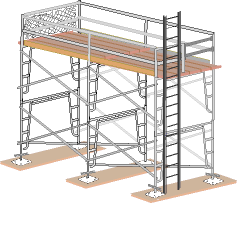Secure and Efficient Scaffolding in Surrey for Any Construction Task
Secure and Efficient Scaffolding in Surrey for Any Construction Task
Blog Article
Checking Out the Numerous Types of Scaffolding Utilized in Construction Tasks
The construction market relies greatly on various types of scaffolding to meet details project needs, each offering distinct advantages and applications. Traditional structure scaffolding gives a strong foundation for basic tasks, while suspended scaffolding is essential for job on skyscraper frameworks.

Conventional Framework Scaffolding
Typical framework scaffolding is just one of one of the most extensively utilized techniques in the building and construction industry as a result of its robustness and versatility. This system contains horizontal and vertical frames that are set up to produce a stable platform for employees and products. The main components consist of upright posts, horizontal journals, and angled braces, which with each other provide a solid framework that can support considerable tons.
One of the key benefits of standard frame scaffolding is its flexibility to numerous construction projects, varying from household buildings to huge industrial frameworks. The modular style permits easy assembly and disassembly, making it reliable for both temporary and long-lasting projects. Additionally, the system can be tailored in height and size, suiting different building styles and website conditions.
Safety is critical in scaffolding applications, and typical structure systems are furnished with guardrails and toe boards to stop drops and ensure worker protection. In addition, routine inspections and adherence to safety and security laws are important in preserving the honesty of the scaffold. Generally, standard frame scaffolding stays a basic selection in the construction market, offering a reputable system for labor and boosting overall task performance

Suspended Scaffolding
Suspended scaffolding supplies an unique service for building and construction jobs that call for access to elevated surface areas, particularly in scenarios where conventional structure scaffolding might be not practical. This sort of scaffolding is generally suspended from the roofing or upper degrees of a framework, utilizing a system of platforms, pulleys, and ropes to create a functioning area that can be adapted to numerous elevations.
Among the key benefits of put on hold scaffolding is its adaptability. It can be conveniently repositioned or lowered to accommodate changes in building needs, making it optimal for tasks such as home window setup, frontage work, and upkeep on skyscrapers. Additionally, the marginal footprint of suspended scaffolding enables for far better use of ground area in urban atmospheres, where room is usually restricted.
Safety and security is a critical consideration in the use of put on hold scaffolding. In general, suspended scaffolding supplies a efficient and reliable remedy for accessing hard-to-reach locations in various building situations, improving both efficiency and security on website.
System Scaffolding
System scaffolding, usually regarded as a modern-day remedy in the scaffolding industry, is composed of pre-engineered elements that can be rapidly constructed and adjusted for numerous construction tasks. Scaffolding. This kind of scaffolding is identified by its modular layout, which permits versatility and effectiveness on task sites, accommodating various heights and architectural needs
Generally made from high-strength steel or aluminum, system scaffolding offers enhanced durability and security. The elements consist of upright messages, straight ledgers, and angled dental braces, which interconnect firmly, guaranteeing a robust structure. The style frequently includes standardized fittings, streamlining assembly and disassembly procedures, consequently minimizing labor time and costs.

Rolling Scaffolding
Rolling scaffolding is a functional choice to traditional fixed scaffolding, created for wheelchair and simplicity of use on building and construction websites. This type of scaffolding consists of a system sustained by frameworks with wheels, enabling workers to quickly transfer it as required. The flexibility attribute reference significantly enhances performance, as it lessens downtime connected with assembling and taking apart dealt with scaffolding.
Normally created from light-weight materials such as aluminum or steel, rolling scaffolding supplies a sturdy yet portable remedy for jobs requiring regular repositioning - Scaffolding. It is specifically helpful in tasks such as paint, drywall installation, and electric job, where access to numerous heights and areas is needed
Security is paramount in rolling scaffolding layout, with attributes such as securing wheels to avoid unintentional activity when being used, and guardrails to shield employees from drops. Furthermore, many models are adjustable in height, suiting various job needs.
Cantilever Scaffolding

The style of cantilever scaffolding normally entails making use of braces or arms secured to a building or structure, enabling the system to expand external securely. Security is vital; therefore, these scaffolds need to be crafted to stand up to different loads and ecological conditions. Routine assessment and maintenance are important to ensure architectural integrity and worker security.
Cantilever scaffolding is preferred for its versatility and reliable use area, making it a popular selection in metropolitan settings where area constraints are usual. It facilitates much easier accessibility to high altitudes, try this out ultimately adding to the overall effectiveness of building tasks. As with all scaffolding kinds, proper training and adherence to safety and security criteria are important for workers making use of cantilever scaffolding.
Verdict
Traditional framework scaffolding provides security, while suspended scaffolding supplies versatility for elevated tasks. System scaffolding assists in quick setting up, and rolling scaffolding enhances mobility for differing job Find Out More environments.
Conventional frame scaffolding offers a durable structure for basic tasks, while put on hold scaffolding is necessary for job on high-rise frameworks.Rolling scaffolding is a versatile choice to standard set scaffolding, made for flexibility and simplicity of usage on building sites. As with all scaffolding types, proper training and adherence to safety criteria are essential for employees using cantilever scaffolding.
Typical frame scaffolding provides security, while suspended scaffolding offers convenience for raised jobs. System scaffolding assists in quick setting up, and rolling scaffolding improves wheelchair for varying work settings.
Report this page